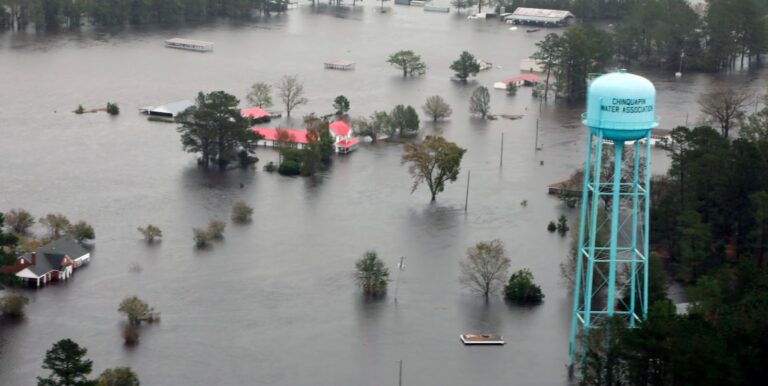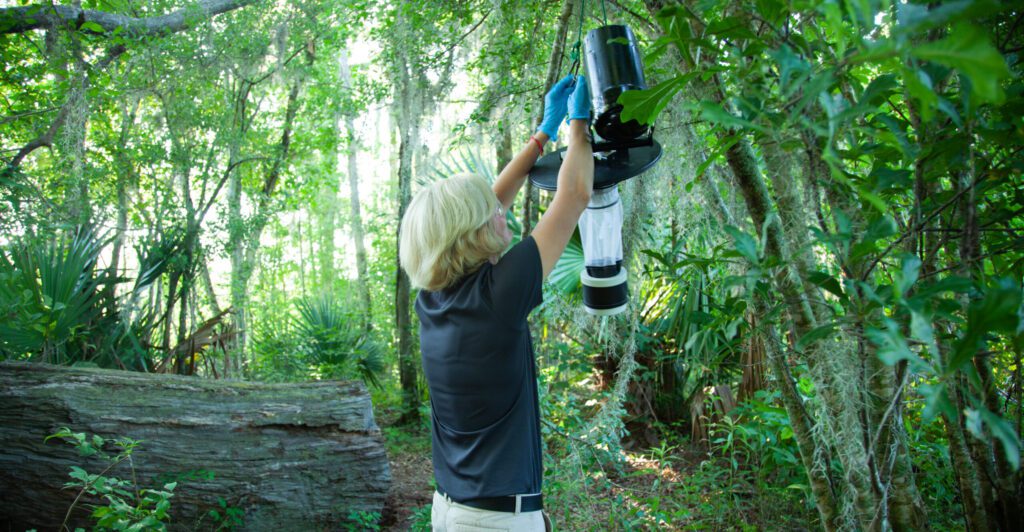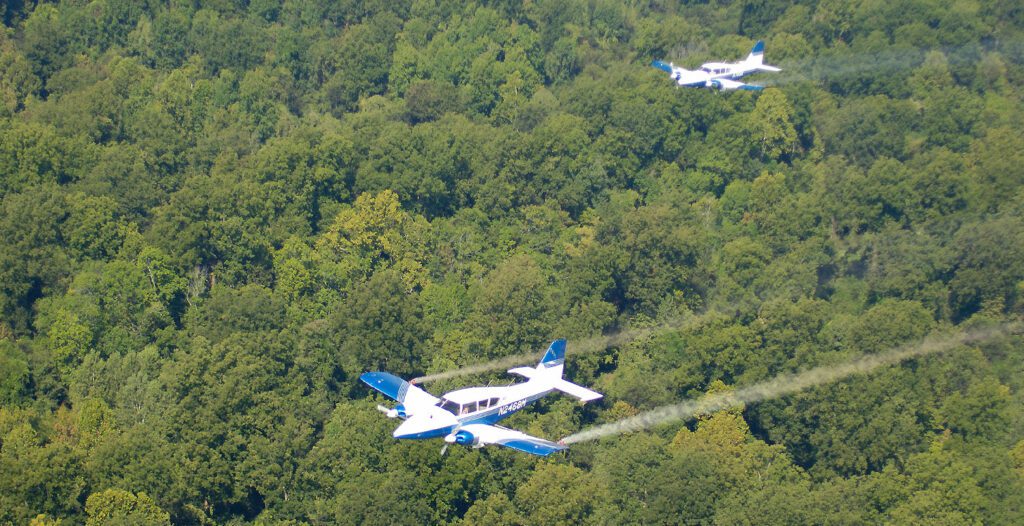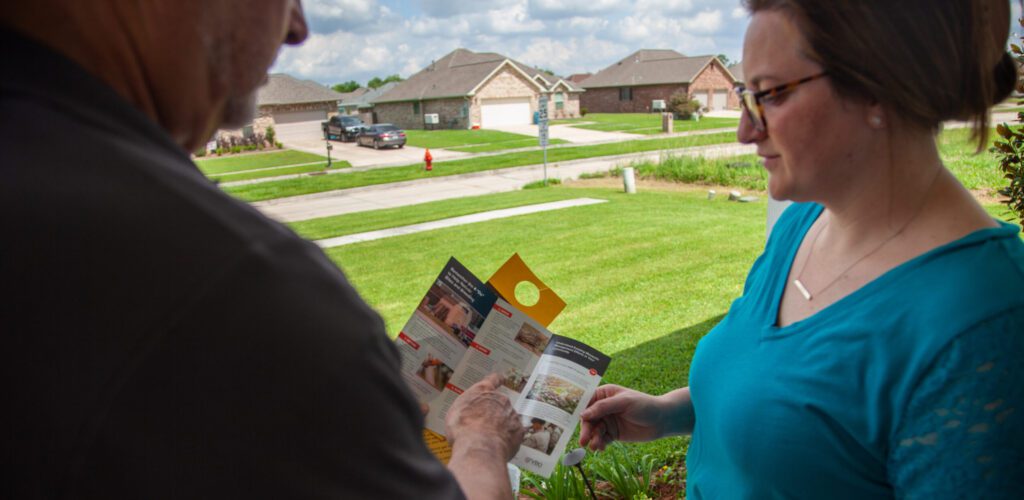Severe weather can be devastating to our communities, bringing heavy rain and flooding, damaging infrastructure, displacing people from their homes, and creating conditions that promote overwhelming mosquito populations. Luckily, it is possible for communities to prepare mosquito management plans ahead of time, so they can be put into action as soon as an incoming disaster is detected.
Following a major storm, mosquito problems develop in a few ways. When flooding occurs, mosquito eggs previously laid by floodwater mosquitoes in moist soil areas will begin to hatch, resulting in abundant populations. Additionally, container-breeding mosquitoes, which reproduce in standing water that has pooled in outdoor containers and debris, will hatch and begin searching for a blood meal.

Abundant mosquito populations can force crews and volunteers indoors, potentially slowing debris removal, power restoration, and medical aid. Though many species that appear after storms don’t pose an immediate disease threat, several can become vectors of disease if left unchecked. Culex mosquitoes are a primary vector of West Nile Virus. Aedes aegypti and Aedes albopictus are known to spread Dengue, and Aedes vexans can transmit heartworm to pets.
After a storm, communities must act quickly in order to keep mosquito problems from getting out of control. However, these efforts require a great deal of coordination between community leaders, public health organizations, and government agencies. Inefficient communication can waste valuable time and pull attention away from other urgent recovery obligations. Stakeholders can prepare by partnering with a mosquito management company to develop emergency response contingency plans.

By partnering with a mosquito management company with a mission to protect public health, communities can ensure the prompt execution of mosquito control measures. Effective response programs begin with pre-mission surveillance to gather information about local mosquito species, population dynamics, and the presence of disease. Prior to the storm, ground crews and pilots will map the physical characteristics of the region, identifying areas that may pose accessibility issues, contain endangered species, or be most vulnerable to flooding.
Your mosquito management partner can also provide guidance on accessing FEMA funds. Districts seeking federal aid for mosquito control need to demonstrate the necessity of post-storm mosquito suppression. Having a comprehensive mosquito abatement program in place before the disaster strikes increases the chances of receiving this funding. Districts that collect baseline data through regular trapping and testing can more easily demonstrate an increase in mosquito populations and justify the use of funds.

Public education is another essential component of storm preparation. Community members can help support mosquito control measures by ensuring water can flow or drain properly when the time comes. This includes removing vegetation, debris, and other blockages from storm drains and gutters, bringing containers such as buckets, wheelbarrows, pet bowls, kiddie pools, and potted plants indoors, and filling in potholes and low spots that are prone to water collection. Eliminating sources of standing water will help reduce available breeding grounds for mosquitoes after the storm.
Public education also includes distributing tips for personal protection from mosquitoes. For outdoor recovery efforts, community members should be prepared to wear light-colored long sleeves and pants, and an EPA-registered insect repellent. VDCI can aid local organizations and media groups in disseminating this important information and keep the public informed throughout the recovery period.

Navigating post-storm recovery efforts can be challenging and taxing on an entire community. In the face of structural devastation and medical emergencies, mosquito management can become an afterthought. VDCI is committed to helping officials design contingency plans so that they can competently manage recovery efforts during these times of fear and uncertainty. Over the last 25 years, we have led 17 major emergency response missions, most recently following Hurricane Ian, a category 5 disaster in Southwest Florida in 2022.
Does your community have an emergency response contingency plan in place for mosquito control? If not, contact us today to learn how we can help you prepare for the unexpected.
Contact Us to Build Your Emergency Response Plan:
 Since 1992, Vector Disease Control International (VDCI) has taken pride in providing municipalities, mosquito abatement districts, industrial sites, planned communities, homeowners associations, and golf courses with the tools they need to run effective mosquito control programs. We are determined to protect the public health of the communities in which we operate. Our mosquito control professionals have over 100 years of combined experience in the field of public health, specifically vector disease control. We strive to provide the most effective and scientifically sound mosquito surveillance and control programs possible based on an Integrated Mosquito Management approach recommended by the American Mosquito Control Association (AMCA) and Centers for Disease Control and Prevention (CDC). VDCI is the only company in the country that can manage all aspects of an integrated mosquito management program, from surveillance to disease testing to aerial application in emergency situations.
Since 1992, Vector Disease Control International (VDCI) has taken pride in providing municipalities, mosquito abatement districts, industrial sites, planned communities, homeowners associations, and golf courses with the tools they need to run effective mosquito control programs. We are determined to protect the public health of the communities in which we operate. Our mosquito control professionals have over 100 years of combined experience in the field of public health, specifically vector disease control. We strive to provide the most effective and scientifically sound mosquito surveillance and control programs possible based on an Integrated Mosquito Management approach recommended by the American Mosquito Control Association (AMCA) and Centers for Disease Control and Prevention (CDC). VDCI is the only company in the country that can manage all aspects of an integrated mosquito management program, from surveillance to disease testing to aerial application in emergency situations.

